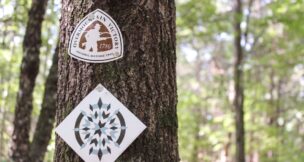Conservation Partnership Gives Head Start to Endangered Gopher Frogs
CRBR Biz Wire //June 16, 2023//
Conservation Partnership Gives Head Start to Endangered Gopher Frogs
CRBR Biz Wire //June 16, 2023//
Columbia, S.C. – Riverbanks Zoo and Garden and the South Carolina Department of Natural Resources (SCDNR) once again partnered to provide a “head start” to the state-endangered gopher frog. As a result, 89 juvenile gopher frogs were released at a SCDNR facility. Add in a graduate student with fresh ideas and grant funding, and the partnership is building more hope for the future of this at-risk species.
Head starting begins with eggs collected from the wild that are reared in human care as tadpoles. Once metamorphosis takes place, the frogs are released into the wild to grow and support their population. In the wild, most gopher frog tadpoles do not make it through metamorphosis due to predation and insufficient habitat within their range.
The native species has become critically endangered as the result of habitat loss. SCDNR recently restored historic gopher frog breeding wetlands and upland habitats replicating the natural living conditions for the species. Last year, Adam McFall, a graduate student at University of Georgia Savannah River Ecology Lab, applied for and received an $8,500 grant from Riverbanks’ Satch Krantz Conservation Fund. When asked what this meant for his research, McFall said, “The SKCF has been a big milestone for me on a personal level. It’s my first attempt at applying for a grant start to finish, and I’m humbled to be a recipient of the grant. The kind of conservation Riverbanks stands for and supports lines up really well with what our team is trying to accomplish.”
Most gopher frog release programs wait for the frogs to mature a little longer before releasing them into the wild, but McFall had a few ideas he wanted to try. By incorporating new metamorphs, McFall is attempting to increase the juvenile population and build site fidelity early on, which means the frogs are more likely to stay where they are released and find refuge in burrows quickly. McFall also plans to test survival rates between hard releases (frogs put straight into the wild) and soft releases (frogs released in a contained space for a designated amount of time).
Gopher frogs are normally hard-released. Expanding on his soft release method, Adam explained, “Soft releases are not a new idea, they’ve been used as a conservation solution for other taxa including birds, reptiles, fish, and even some mammals. But it’s brand new for gopher frogs, and only a handful of studies have looked at soft releasing any amphibian species for that matter. So going into this project, I am of course curious how the frogs will respond to it.” McFall’s MS advisor, Dr. Stacey Lance added, “McFall did exactly what every advisor wants to see—he learned something with his MS research and immediately sought opportunities to build upon those findings.”
With the aid of the grant and Riverbanks staff, eighteen enclosures were built, burrows were excavated, and the hard release frogs were fitted with transmitters tracking their locations and patterns. Riverbanks employees also got to roll up their sleeves to help. Hunter Balog, Conservation Project Manager for the Zoo shared, “This project was a great opportunity for some of our staff to see conservation up close with a native species that is at-risk for extinction across its habitat range.”
SCDNR has partnered with Riverbanks as well as state and federal hatcheries on these head start programs for many years. When asked about their involvement with the student’s work, Andrew Grosse, State Herpetologist for the Department answered, “Adam’s project is taking our effort a step further by attempting to determine if there’s a better way to release frogs that ensures greater survivorship.” Grosse continues,” There is so much we still don’t know about the reptiles and amphibians in South Carolina, especially these cryptic species, and we need to remain open-minded to new ideas and techniques that will help us manage these species in a way that ensures their persistence on the landscape.”
Public Relations Manager Matt Perron added, “Riverbanks is thrilled to continue these partnerships to help ensure future sustainable populations of endangered native species. It’s amazing to see the next generation of conservationists taking the reins to ensure conservation continues and that new methods are constantly being developed to further these efforts.”
Riverbanks Zoo and Garden is home to more than 3,000 magnificent and fascinating animals and one of America’s best public gardens. The Zoo opened on April 25, 1974, and for nearly five decades, has connected individuals, families and school children with the natural world. Riverbanks is an accredited member of the Association of Zoos and Aquariums and is recognized as a global leader in animal care and welfare, education, recreation, science and wildlife conservation. It is the mission of the Zoo and Garden to create meaningful connections and inspire actions that will have a lasting impact on conservation. For more information, visit riverbanks.org.
t













